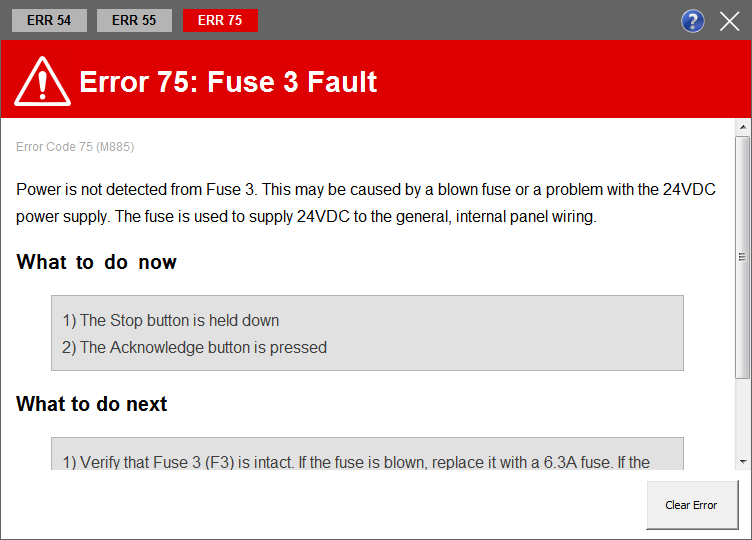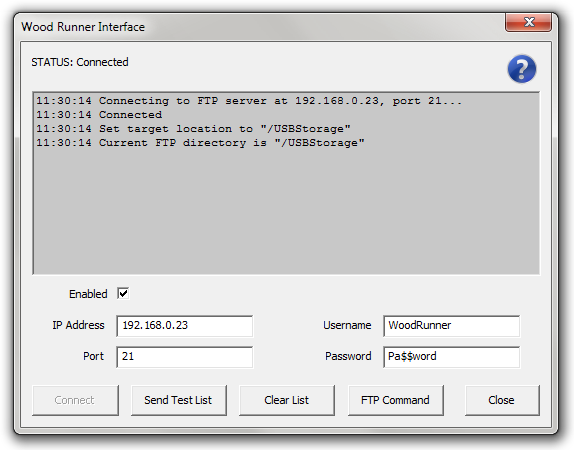Control Bar
The control bar is available at the bottom of the main window. It is broken into various sections, each of which performs different functions. It can be used to operate and adjust the saw manually, set up the printer, diagnose faults or monitor the functioning.
 Command buttons
Command buttons
The command buttons on the left of the control bar are used to open additional windows.
|
Opens the Setup window. Note: This feature is available to Engineer access level only. |
|
|
Opens the Manual Mode window. |
|
|
Opens the Printer Setup window. |
|
|
Opens the Diagnostics window. |
 Saw loading options
Saw loading options
These checkboxes offer additional cutting options during production.
Note: these options are overrides and will not change the quantities cut of the selected members (i.e. if there are two of the same members to cut, enabling 2* Thick will only count as cutting one member).
- 2* Thick: indicates to the saw that two pieces of timber are stacked one on top of the other.
- 2* Wide: indicates to the saw that two pieces of timber are stacked side by side.
-
Rotate: indicates to the saw that the stick is rotated 90° from the position initially set in the file (flat or on its edge).
Note: this may be useful when the saw is not able to perform a cut in the initially set position.
-
Simulation: simulates the cutting functions when Simple is unable to communicate with the saw.
Note: this option is hidden when communication with the saw is present.
 Speed sliders
Speed sliders
These sliders will dynamically change the speed of the saw's feed rates while cutting and can be changed at any time:
- Cutting Speed: alters the speed of the cutting action while in a cut (i.e. the speed at which the blade is moved through the timber, not the actual speed of the blade itself).
- Moving Speed: alters the speed of the timber when moving through the saw from one cut position to another.
 Monitoring panel
Monitoring panel
The monitoring panel on the right of the control bar gives the current position and status of any particular axis or feeder, as well as the status of the feeder sensors, clamp rollers and saw blade.
Note: the colour of the indicator light gives the current status as follows: Normal operation (ready and active)
Normal operation (ready and active) Not homed or on software limits
Not homed or on software limits Presence of a fault (Amp Fault or Urgent FE error)
Presence of a fault (Amp Fault or Urgent FE error) Not initialised
Not initialised
|
|
Gives the current position and status of the left feeder. |
|
|
Gives the current position and status of the Y‑axis. |
|
|
Gives the current position and status of the Z‑axis. |
|
|
Gives the current position and status of the B‑axis. |
|
|
Gives the current position and status of the C‑axis. |
|
|
Gives the current position and status of the right feeder. |
|
|
Indicates that the corresponding top clamp roller is in the idle position (away from the timber). |
|
Indicates that the corresponding top clamp roller is in the actuated position (clamped against the timber). |
|
|
Indicates that the corresponding feeder sensor is obstructed (timber is detected). |
|
Indicates that the corresponding feeder sensor is clear (timber is not detected). |
|
|
Indicates that the corresponding side clamp roller is in the idle position (away from the timber). |
|
Indicates that the corresponding side clamp roller is in the actuated position (clamped against the timber). |
|
|
Indicates that the saw blade is off. |
|
Indicates that the saw blade is on. |
|
|
Gives the current speed of the saw blade (in rpm). |
||
 Message bar
Message bar
The message bar is located just below the speed sliders. It shows the login name of the current user, messages relating to any function currently running, as well as warning messages.
 Uptime counter
Uptime counter
The uptime counter is located just below the speed sliders. It indicates how long the saw has actually been cutting since midnight.
 Error notification
Error notification
An error notification icon can be displayed at the right end of the control bar.
Note: "Error Codes" must be selected as Error System in the General tab of the Options window for the icon to be displayed.
The icon indicates the following:
|
|
No error is present. |
|
|
One or more errors occurred and attention is required. Note: Critical errors and errors that require immediate operator action will force the |

This window gives a description of the error. If there are multiple errors pending, you can switch between them by clicking the tabs at the top of the window. The "What to do now" section has instructions for immediate action to continue cutting. The "What to do next" section contains instructions to fault-find the issue if it will not clear. Some errors can simply be dismissed by clicking  .
.
 WoodRunner status (third‑party product)
WoodRunner status (third‑party product)
If a WoodRunner is installed, a dedicated icon will be displayed at the right end of the control bar.
Note: "WoodRunner" must be selected as Bunk Feeder in the General tab of the Options window.
The icon gives the current status as follows:
|
|
The connection to the WoodRunner is active. |
|
|
The connection to the WoodRunner is disabled. To enable it, do the following:
|
|
|
The connection to the WoodRunner has not been initiated or has failed. To solve the issue, do the following:
|
CAUTIONWoodRunner connection settings must not be altered unless communication issues have been diagnosed.






















 .
.